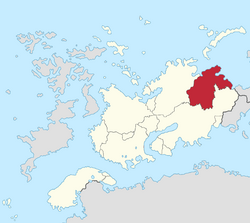Voshagne: Difference between revisions
No edit summary |
|||
| Line 85: | Line 85: | ||
===Interior War=== | ===Interior War=== | ||
{{main|Interior War}} | {{main|Atmoran Interior War}} | ||
===Modern era=== | ===Modern era=== | ||
Revision as of 20:04, 2 September 2024
This article is incomplete because it is pending further input from participants, or it is a work-in-progress by one author. Please comment on this article's talk page to share your input, comments and questions. Note: To contribute to this article, you may need to seek help from the author(s) of this page. |
Voshagne | |
|---|---|
 | |
| Country | |
| State | |
| Largest city | Novigrad |
| Area | |
| • Total | 1,157,271 km2 (446,825 sq mi) |
| Population (2015) | |
| • Total | 6,238,006 |
| • Density | 5.4/km2 (14/sq mi) |
| Demonym | Voshanees/ese |
Voshagne (/vɔshəni/; Voshanskya: Voshana; Vozhski: Vashań [vɔʂanʲ]) is a region of northwestern Lieseltania, comprosing of the provinces of Brest, Brunna, Castamere, Stakena, and Novigrad. It has an area of 1,157,271 km² (446,825 sq mi) and 6.2 million people.
Etymology
Geography
Subdivision
History
Prehistory
Slavic princely states
Northern War and the Voshan Wars
Lieseltanian Era
Forced explusions
Interior War
Modern era
Winter War
Demographics
Ethnic groups
The Voshagne is home to the Wends, Diebalsky, Wielzians, and the Milzenany along with the Nahane, Athabaskan, Mesties and the Inuit peoples, the recognised indigenous peoples of Northern Lieselania. Additionally the region is primarily inhabited by the Voshany and the Atmoran Noordlings, who came about settling with the Noordnederzetting along with Deportation of the Lieseltanian Slavs in the 18th century.
Prior to the northern settlements and the conquest of the Voshagne by Lieseltania the Slavic clans and the indigenous nations of the Voshagne resided in the Great Lakes Region. With the slavs primarily residing on the eastern banks of the lakes with the indigenous having the western highlands.
The largest ethnic groups in the Voshagne are 51.7% as Atmorans (3.225 million), 17.5% as Voshany (1.091 million), 14.3% as Slavs (892k), 13.76% as Indigenous (858k), 1.2% as Mizuhese (74.5k), and others (1.52%)
Religion
Religion in Voshagne (2016)
